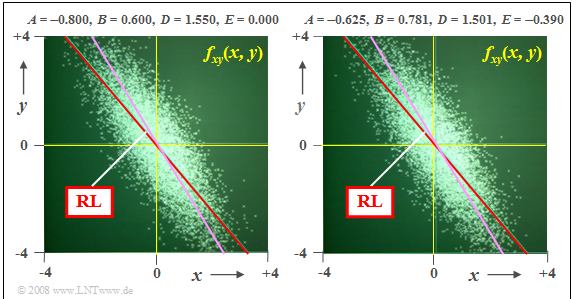Contents
Prerequisites and mean values
Throughout the chapter "Linear Combinations of Random Variables" we make the following assumptions:
- The random variables $u$ and $v$ are zero mean each ⇒ $m_u = m_v = 0$ and also statistically independent of each other ⇒ $ρ_{uv} = 0$.
- The two random variables $u$ and $v$ each have equal standard deviation $σ$. No statement is made about the nature of the distribution.
- Let the two random variables $x$ and $y$ be linear combinations of $u$ and $v$, where:
- $$x=A \cdot u + B \cdot v + C,$$
- $$y=D \cdot u + E \cdot v + F.$$
Thus, for the (linear) mean values of the new random variables $x$ and $y$ we obtain according to the general rules of calculation for expected values:
- $$m_x =A \cdot m_u + B \cdot m_v + C =C,$$
- $$m_y =D \cdot m_u + E \cdot m_v + F =F.$$
Thus, the coefficients $C$ and $F$ give only the mean values of $x$ and $y$. Both are always set to zero in the following sections.
Resulting correlation coefficient
Let us now consider the »variances« of the random variables according to the linear combinations.
- For the random variable $x$ holds independently of the parameter $C$:
- $$\sigma _x ^2 = {\rm E}\big[x ^{\rm 2}\big] = A^{\rm 2} \cdot {\rm E}\big[u^{\rm 2}\big] + B^{\rm 2} \cdot {\rm E}\big[v^{\rm 2}\big] + {\rm 2} \cdot A \cdot B \cdot {\rm E}\big[u \cdot v\big].$$
- The expected values of $u^2$ and $v^2$ are by definition equal to $σ^2$, because $u$ and $v$ are zero mean.
- Since $u$ and $v$ are moreover assumed to be statistically independent, one can write for the expected value of the product:
- $${\rm E}\big[u \cdot v\big] = {\rm E}\big[u\big] \cdot {\rm E}\big[v\big] = m_u \cdot m_v = \rm 0.$$
- Thus, for the variances of the random variables formed by linear combinations, we obtain:
- $$\sigma _x ^2 =(A^2 + B^2) \cdot \sigma ^2,$$
- $$\sigma _y ^2 =(D^2 + E^2) \cdot \sigma ^2.$$
The »covariance« $μ_{xy}$ is identical to the joint moment $m_{xy}$ for zero mean random variables $x$ and $y$ ⇒ $C = F = 0$:
- $$\mu_{xy } = m_{xy } = {\rm E}\big[x \cdot y\big] = {\rm E}\big[(A \cdot u + B \cdot v)\cdot (D \cdot u + E \cdot v)\big].$$
Note here that ${\rm E}\big[ \text{...} \big]$ denotes an expected value, while $E$ describes a coefficient.
$\text{Conclusion:}$ After evaluating this equation in an analogous manner to above, it follows:
- $$\mu_{xy } = (A \cdot D + B \cdot E) \cdot \sigma^{\rm 2 } \hspace{0.3cm}\Rightarrow\hspace{0.3cm} \rho_{xy } = \frac{\rho_{xy } }{\sigma_x \cdot \sigma_y} = \frac {A \cdot D + B \cdot E}{\sqrt{(A^{\rm 2}+B^{\rm 2})(D^{\rm 2}+E^{\rm 2} ) } }. $$
We now exclude two special cases:
- $A = B = 0$ ⇒ $x ≡ 0$,
- $D = E = 0$ ⇒ $y ≡ 0$.
Then the above equation always yields unique values for the correlation coefficient in the range $-1 ≤ ρ_{xy} ≤ +1$.
$\text{Example 1:}$ If we set $A = E = 0$, we get the correlation coefficient $ρ_{xy} = 0$. This result is insightful:
- Now $x$ depends only on $v$ and $y$ depends exclusively on $u$.
- But since $u$ and $v$ were assumed to be statistically independent, there are also no relationships between $x$ and $y$.
- Similarly, $ρ_{xy} = 0$ results for the combination $B = D = 0$.
$\text{Example 2:}$ The constellation $B = E = 0$ leads to the fact that both $x$ and $y$ depend only on $u$. Then the following correlation coefficient is obtained:
- $$\rho_{xy } = \frac {A \cdot D }{\sqrt{A^{\rm 2}\cdot D^{\rm 2} } } = \frac {A \cdot D }{\vert A\vert \cdot D\vert } =\pm 1. $$
- If $A$ and $D$ have the same sign, then $ρ_{xy} = +1$.
- For different signs, the correlation coefficient is $-1$.
- Also for $A = D = 0:$ The coefficient $ρ_{xy} = ±1$, if $B \ne 0$ and $E \ne 0$ holds.
The $\text{previously used equations}$ can be used to generate a two-dimensional random variable $(x,\hspace{0.08cm} y)$ with given characteristics $σ_x$, $σ_y$ and $ρ_{xy}$.
- If no further preconditions are met other than these three nominal values, one of the four coefficients $A, \ B, \ D$ and $E$ is arbitrary.
- In the following, we always arbitrarily set $E = 0$ .
- With the further specification that the statistically independent random variables $u$ and $v$ each have standard deviation $σ =1$ we obtain:
- $$D = \sigma_y, \hspace{0.5cm} A = \sigma_x \cdot \rho_{xy}, \hspace{0.5cm} B = \sigma_x \cdot \sqrt {1-\rho_{xy}^2}.$$
- For $σ ≠ 1$ these values must still be divided by $σ$ in each case.
$\text{Example 3:}$ We always assume zero mean Gaussian random variables $u$ and $v$. Both have variance $σ^2 = 1$.
$(1)$ To generate a two-dimensional random variable with desired characteristics $σ_x =1$, $σ_y = 1.55$ and $ρ_{xy} = -0.8$ the parameter set is suitable, for example:
- $$A = -0.8, \; B = 0.6, \; D = 1.55, \; E = 0.$$
- This parameter set underlies the left graph.
- The regression line $(\rm RL)$ is shown in red.
- It runs at an angle of about $-50^\circ$.
- Drawn in purple is the ellipse major axis, which lies slightly above the regression line.
$(2)$ The parameter set for the right graph is:
- $$A = -0.625,\; B = 0.781,\; D = 1.501,\; E = -0.390.$$
- In a statistical sense, the same result is obtained even though the two point clouds differ in detail.
- With respect to regression line $(\rm RL)$ and ellipse major axis $(\rm EA)$, there is no difference with respect to the parameter set $(1)$.
Exercises for the chapter
Exercise 4.7: Weighted Sum and Difference
Exercise 4.7Z: Generation of a Joint PDF
Exercise 4.8: Diamond-shaped Joint PDF
